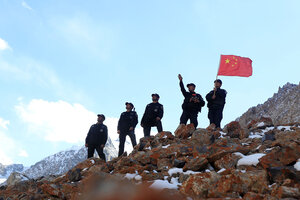US exit leaves a roiling Afghanistan in China’s court

Chinese police and border officers inspect the border with Pakistan in Xinjiang province in China in 2020. Xinjiang also borders Afghanistan, and in the 1990s, the ruling Taliban provided a base for a group of Uyghur fighters opposed to Chinese rule.
China Daily/Reuters/File
London
Two critical struggles are underway in Afghanistan on the heels of America’s withdrawal. One is the advance of the Islamist Taliban. Yet it’s the other that could ultimately determine the shape of a future government, as well as the balance of power in the region and beyond.
That one involves Afghanistan’s neighbors – above all, China – and a dramatic shift in their political priorities as a result of the speed of the American pullout, the Taliban’s capture of key border areas, and an escalating concern over the prospect of all-out civil war.
The ironic result: While all these countries – China, Pakistan, Iran, and the Russian-allied states of formerly Soviet Central Asia – have been sharply critical of America’s Afghan war, their interest now jibes with what Washington has been trying, and so far failing, to put in place. Their concern, too, is to secure a broadly acceptable governing coalition in Afghanistan capable of delivering political stability.
Why We Wrote This
Afghanistan’s influential neighbors have never liked the U.S. presence on their borders. But the U.S. withdrawal has underscored a shared interest that now falls more heavily to them: a stable government.
That kind of political settlement still seems a tall order, despite their own increasingly active diplomatic efforts and the planned resumption in the coming days of U.S.-backed talks between Afghan and Taliban representatives in the Gulf state of Qatar.
But the immediate focus among Afghanistan’s neighbors is to keep the violence from spiraling out of control. It’s a message they’ve been making clear in recent weeks to the Taliban’s representatives, especially since their capture of border areas with Iran, Pakistan, and the former Soviet republics of Tajikistan and Turkmenistan.
Worry about refugees
The Iranians held talks with the Taliban and Afghan government officials earlier this month and stressed to the Taliban their concern to avoid an influx of hundreds of thousands of refugees. They even secured Taliban representatives’ signature on a joint statement that, on paper at least, renounced attacks on schools, hospitals, and other civilian facilities and backed the idea of a negotiated settlement on the country’s future.
Russia began conveying its concerns after the Taliban took hold of posts on the border with formerly Soviet Tajikistan, sending hundreds of Afghan troops fleeing across the frontier.
Significantly, even Pakistan has voiced its concern, despite having been for years the Taliban’s key regional supporter. The Pakistanis’ worry is not just a new inrush of refugees, but the risk of the Taliban advances emboldening anti-Pakistan groups to mount cross-border attacks. Pakistan has made clear it would not relish a return to the Taliban’s violently repressive rule of 1990s Afghanistan.
The key voice, however, is China’s. The Chinese have security concerns, too: Afghanistan borders the province of Xinjiang, where the government of Chinese leader Xi Jinping has confined hundreds of thousands of Uyghur Muslims to “reeducation” camps. In the 1990s, the ruling Taliban provided a base for a group of Uyghur fighters opposed to Chinese rule in Xinjiang.
But China’s interests in Afghanistan’s future go deeper. A stable government there would be a potentially important boost in China’s move to expand its economic and political clout amid what Mr. Xi has called the “decline” of the United States and other Western democracies.
The “corridor”
A flagship project in China’s nearly $1 trillion Belt and Road initiative, which finances infrastructure projects in developing countries, often in return for access to natural resources, has been the so-called corridor – CPEC, or the China-Pakistan Economic Corridor. It skirts Afghanistan, between China and its main regional ally, Pakistan. Unchecked Afghan violence and political instability could imperil that.
China’s hope now seems to be to trade support for a Taliban role in a future Afghan government – with Pakistan keeping the Islamists from attempting a full-scale takeover – for the prospect of Belt and Road projects in Afghanistan.
China already has a long-term lease on a major Afghan copper deposit, which it has yet to develop. It also has interests in developing oil deposits and mining valuable rare-earth minerals there.
The open question is whether this will work. Can China realistically hope to secure an end to the violence, much less the kind of political compromise necessary for long-term stability?
It does have a few things going for it. It is indisputably the major power in the region. One dramatic sign of its political and economic weight has been recent public statements by both the Taliban and Pakistani Prime Minister Imran Khan – high-profile champions of Muslims worldwide – saying that they have no criticism of China’s mass incarceration of the Uyghurs.
But the main problem may turn out to be the first of the twin struggles raging over Afghanistan: the battle on ground.
There are growing signs of a divide between what the Taliban’s political representatives are saying and what their fighters are doing. Despite the conciliatory words that Taliban diplomats signed on to in Iran, Taliban takeovers of Afghan villages have included immediate restrictions on women’s rights, the burning of schools, and threats of violence against those who don’t want a return to the Taliban-governed country of two decades ago.
There are also combatants on the other side: the revived mujahideen from the days of the Soviet invasion and, crucially, the Afghan army, trained, equipped, and still funded by the Americans.
And a final irony, perhaps: The best hope for a stable future Afghanistan may lie in some form of shared diplomatic engagement by two major powers that are, themselves, on increasingly tense terms: America and China.

